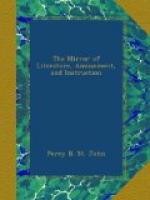that this “piece of phantasmagoria was conducted
by means of the secret passages and recesses in the
Labyrinth of Rosamond”—it must be
admitted, a very convenient scene for such a farce.
Sir Walter says, “I have not the book at hand”—neither
have we; but we may probably allude to this curious
affair on some future occasion. In the meantime,
if our present reference should kindle the curiosity
of the reader, and he may not be disposed to await
our time, we beg to recommend him to Glanville’s
well-known work on witchcraft, which not only contains
Dr. Plot’s narrative of the Woodstock disturbances,
but a multitude of argument for all who are sceptical
of this and similar mysteries. This is an age
of inquiry, and we do not see why such follies should
be left unturned—from Priam’s shade
to the murderous dreams and omens of our own times.
[1] Sagittarius—and T.W. of Hoxton.
[2] For an abstract of “Woodstock,”
an engraving, and much
valuable information respecting
the palace, see our vol. vii.
pp. 289—316—322—327—338,
&c.
[3] As there is a vulgar error
on Rosamond’s being buried in the
labyrinth, we subjoin the
following by another correspondent.
Many readers of the mirror, perhaps, have hitherto been only acquainted with the fictitious part of Fair Rosamond’s history. The few subjoined facts, relative to the eventful life of that lady, may be implicitly relied on, as they are very carefully gleaned from the most authenticated sources.
The first mistress to king Henry II. was Rosamond, daughter of Walter Clifford, Baron of Hereford. She was esteemed the greatest beauty in England, and her intrigue with Henry was most probably began when he was not much above sixteen years of age. Very soon after his amorous acquaintance with this lady, the state of political affairs in England required his absence, and he did not again return to this country until the year 1153; so that there must have been a lapse of nearly six years from the period of his first intimacy with Rosamond, to the renewal of that intimacy at his return.
About the year 1157, king Henry took extraordinary precautions to conceal his intrigue from the knowledge of queen Eleanor, a woman, of wonderful spirit and penetration, to whom he had been espoused at the period of his accession to the throne, in 1155. This circumstance has given rise to the romantic tradition of his forming a sort of labyrinth at Woodstock Palace, for the purpose of concealing his fond mistress from the vengeance of Eleanor; but the story of her being murdered in that palace by the queen is perfectly false, for it is sufficiently evident that she retired to the nunnery of Godstow, where she ended her days in peace, though in what year it is difficult to decide. After Rosamond’s decease, the king bestowed large revenues on the convent, in return for which,




